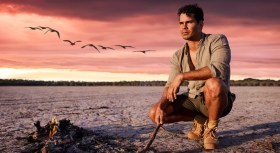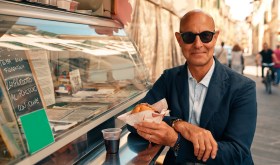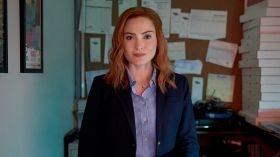After their car plummets from a bridge during a drag race, Mary is the only one of three girls to emerge from the murky water below. That same week, she leaves Kansas and heads west to take up a job as a church organist. It isn’t her calling. “I play for pay,” she tells her neighbour. More likely, she’s driven there by visions of a strange ghoul who haunts her waking hours, or she’s drawn to the eerie pavilion lying silent and abandoned on the Utah salt flats…
I’ll say no more. Inspired by Ambrose Bierce’s short story, An Occurrence at Owl Creek Bridge (1890), the basic plot will likely be familiar to many viewers, having likewise been adapted for any number of films since, including (but not limited to) Brazil [1985], Jacob’s Ladder [1990], Donnie DarkoCarnival of Souls might well be the pick of the lot.
Filmed in three weeks on a budget of $30,000, it’s true that some of Harvey’s direction is a bit static, and John Clifford’s script can be heavy handed in places. The acting is variable. But what makes Carnival of Souls a horror classic is that, 50 years later, it’s still scary. In part this is due to its atmosphere, the starkness and stillness of the photography, together with Gene Moore’s otherworldly organ score. Partly it’s because the horror is psychological – indeed, sociological. Like George A Romero’s early films (Carnival was one of the latter’s influences when making Night of the Living Dead [1968]), it’s all about turning a mirror on the audience. It’s Bierce by way of Albert Camus. It also works as both a religious and an atheistic vision of what lies beyond. Either way, it’s chilling.
Live Live Cinema: Carnival of Souls brings the film to a whole new audience, with a new score composed and performed by Leon Radojkovic and his six-piece band. The actors’ voices are dubbed live by a quartet of very fine actors led by Chelsie Preston Crayford as Mary, with foley (sound effects) provided by Gareth Van Niekerk. All are magnificent.
The score itself certainly weaves its own atmosphere, and is terrific at punctuating the scares(!), but it can also be a bit busy at times. It’s said that the most effective horror lies in the imagination, the unlit corners of the screen, and I tend to think the same applies to music. For me, at any rate, there are moments in the film – such as when Mary explores the pavilion – that Moore’s ‘unremarkable’ organ, drifting at the edges like some faint memory, remains more appropriate and effective.
Quibbles aside, Live Live Cinema: Carnival of Souls is a wonderful evening’s entertainment (‘the best live cinema experience you’ve never seen’ if you missed this current run). Hopefully, it’s the first of a series of similar productions at the Sydney Festival over the coming years.
Rating: 4 out of 5 stars
Sydney Festival presents
Live Live Cinema: Carnival of Souls
Created and composed by Leon Radojkovic
Developed and directed by Oliver Driver
Performed by Chelsie Preston Crayford, Cameron Rhodes, Charlie McDermott and Bronwyn Bradley
Musical performance by Simon Walker, Claire Cowan, Alex Taylor, Matt Ledingham, Alex MacDonald, Johnathan Burgess and Leon Radojkovic
Foley by Gareth Van Niekark
Produced by Phil Evans
Riverside Theatres
January 20–22
www.sydneyfestival.org.au
Also appearing at the 2012 Perth Festival
February 21, 22 and 24
www.perthfestival.com.au
Actors:
Director:
Format:
Country:
Release:





